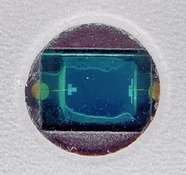albada
Subscriber
I've used the easel meter from Darkroom Automation (@Nicholas Lindan) much, so I can provide a few clues based on that experience with my LED head. The DA meter:
FYI, the LED heads built by myself, @Mal Paso, and @koraks (IIRC), use royal blue (~455 nm) and a normal green of ~525 nm. I have found that 455 nm yields maximum contrast from both Ilford and Foma papers. I remember reading a posting long ago from somebody who uses UV to get max contrast, but my tests show that's not necessary. And the lens probably isn't corrected for UV, so definition might suffer. For your sensor, I think going down to 450 will be fine. Does Ilford's #5 filter really have a peak at 400-420 nm? That's almost UV-A!
@koraks and I use a 660 nm red to be certain to avoid the red sensitivity in Foma papers (and it works well for RA-4).
When printing, I see little use for requirement #2 (measure green/blue for B&W) because the paper-tables "know" what effect filters or green/blue LED settings have on contrast (exposure range). Perhaps this feature would make calibration of paper + developer + filter-system easier.
A final twist: Apart from the common magenta cast, some films with some developers result in a light blue cast, which produces a noticeable shift in both exposure and contrast. I solved this problem by introducing a "bias" feature to the firmware in which green and blue brightnesses (PWM) are shifted by a given number of tenths of stops. Hmm, your requirement #2 could solve this problem automatically.
Mark
- can measure down to about 0.05 lux, which I've found is not quite enough, even with all three LED-chains running full power, forcing me to open up a stop or two to measure some highlights. 0.025 lux would be better.
- integrates over a one-second period, thus updating the display every second. This is fast enough.
- appears to have a fairly flat spectral response.
FYI, the LED heads built by myself, @Mal Paso, and @koraks (IIRC), use royal blue (~455 nm) and a normal green of ~525 nm. I have found that 455 nm yields maximum contrast from both Ilford and Foma papers. I remember reading a posting long ago from somebody who uses UV to get max contrast, but my tests show that's not necessary. And the lens probably isn't corrected for UV, so definition might suffer. For your sensor, I think going down to 450 will be fine. Does Ilford's #5 filter really have a peak at 400-420 nm? That's almost UV-A!
@koraks and I use a 660 nm red to be certain to avoid the red sensitivity in Foma papers (and it works well for RA-4).
When printing, I see little use for requirement #2 (measure green/blue for B&W) because the paper-tables "know" what effect filters or green/blue LED settings have on contrast (exposure range). Perhaps this feature would make calibration of paper + developer + filter-system easier.
A final twist: Apart from the common magenta cast, some films with some developers result in a light blue cast, which produces a noticeable shift in both exposure and contrast. I solved this problem by introducing a "bias" feature to the firmware in which green and blue brightnesses (PWM) are shifted by a given number of tenths of stops. Hmm, your requirement #2 could solve this problem automatically.
Mark





